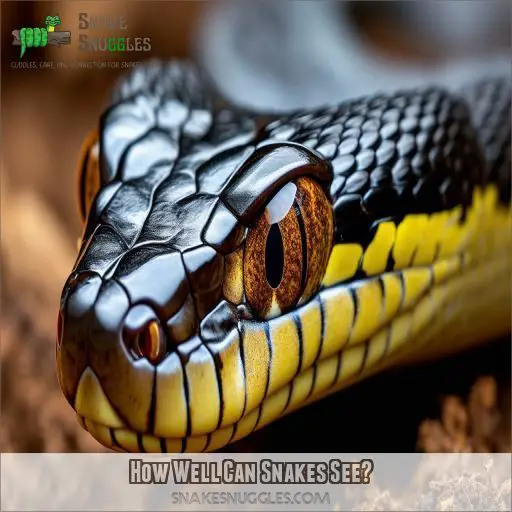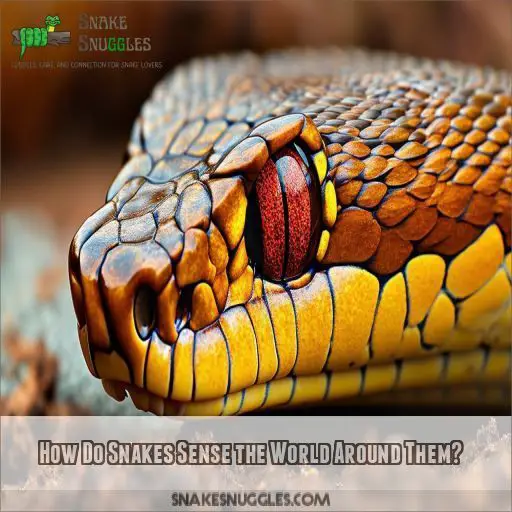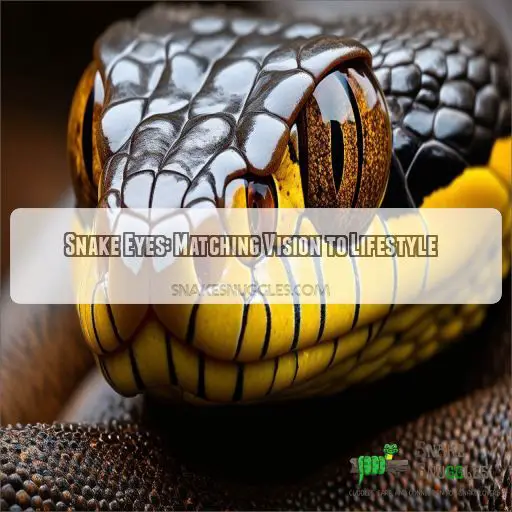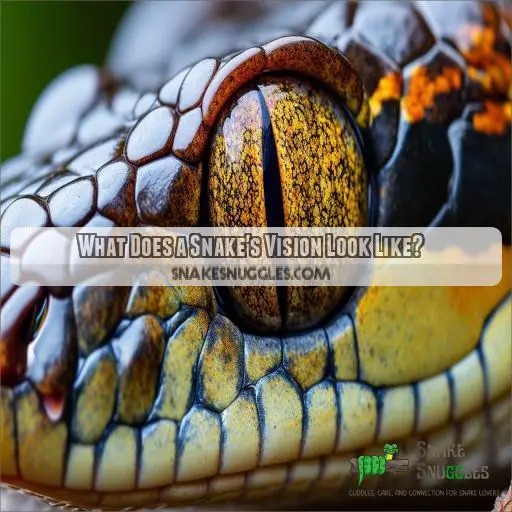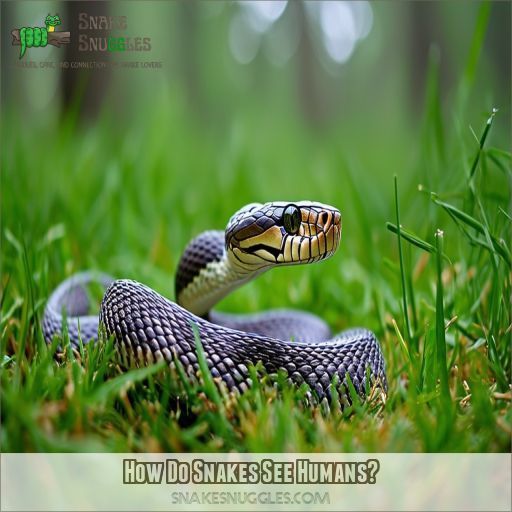This site is supported by our readers. We may earn a commission, at no cost to you, if you purchase through links.
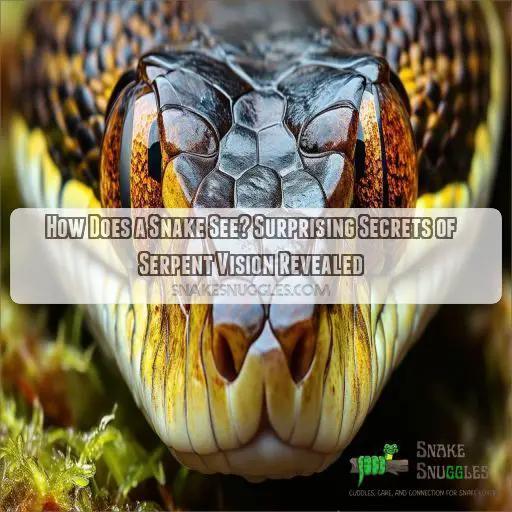
Uncover their secret senses: infrared detection and scent perception.
Explore how these reptiles perceive and adapt to their diverse habitats.
Table Of Contents
- Key Takeaways
- How Does a Snake See?
- How Well Can Snakes See?
- How Do Snakes Sense the World Around Them?
- Snake Eyes: Matching Vision to Lifestyle
- What Does a Snake’s Vision Look Like?
- How Do Snakes See Humans?
- Do Snakes Have Good Eyesight?
- Frequently Asked Questions (FAQs)
- What does a snakes vision look like?
- How do snakes see humans?
- Do snakes have good eyesight?
- Do snakes see with their eyes or tongue?
- How does a snake see humans?
- What is the purpose of a snakes pit organ?
- Why do some snakes have eyes on top of their heads?
- How does a snakes sense of smell work?
- How does a snakes vision help it hunt?
- Conclusion
Key Takeaways
- Snakes have diverse vision, with some excelling in low-light conditions and others boasting sharp daytime vision.
- They possess infrared detection abilities that allow them to "see" the heat signatures of their prey, making them formidable nocturnal hunters.
- Snakes use their tongues to collect scent particles and create a detailed olfactory map of their surroundings for analysis.
- These unique visual adaptations, coupled with infrared detection and scent perception, aid snakes in navigating their environment, hunting effectively, and avoiding predators.
How Does a Snake See?
Snake vision varies widely and is species-dependent. Some arboreal snakes have sharp eyesight, while nocturnal snakes rely more on heat detection for navigation and hunting. Hence, snake vision affects their behavior and hunting strategies.
While some snakes have keen daytime vision, others are adapted to low-light conditions or can detect ultraviolet light. A snake’s vision type is closely related to its lifestyle and hunting techniques.
To learn more about how snakes perceive the world and their unique environmental sensing mechanisms, continue reading.
How Well Can Snakes See?
You might be surprised to learn that a snake’s visual acuity varies greatly among species, with arboreal snakes having excellent vision while nocturnal ones rely more on heat detection.
This variation in visual ability directly influences their hunting strategies and behavior, with some snakes using sharp eyesight to spot prey from afar while others depend on other senses for successful predation.
Visual Acuity
You might be surprised to learn that a snake’s visual acuity isn’t as poor as you’d think. Their eyes, protected by transparent scales, have unique optical adaptations.
The retinal structure, packed with rods and some cones, allows for impressive spectral sensitivity.
While their field of view may be narrow, snakes have developed focus mechanisms that enable them to spot prey with surprising precision.
Would you like to know more about their fascinating visual capabilities?
Type of Vision in Different Snake Species
You’ll find that snake vision varies widely across species. Here’s a quick rundown:
- Arboreal snakes boast sharp eyesight for traversing treetops.
- Nocturnal species have evolved specialized lenses for enhanced low-light vision.
- Some diurnal snakes possess UV vision, giving them an edge in bright environments.
Color perception among snakes isn’t uniform either. While most are dichromatic, their eyesight has evolved to match their lifestyle and habitat.
Impact on Hunting and Behavior
You’ll be amazed at how a snake’s vision impacts its hunting and behavior. Their unique eyesight plays a pivotal role in their survival strategies. Check out this table to see how different snake species use their vision:
| Snake Type | Hunting Style | Visual Adaptation |
|---|---|---|
| Pit Vipers | Ambush | Infrared sensing |
| Tree Snakes | Active | Sharp daytime vision |
| Cobras | Defensive | Threat displays |
| Nocturnal | Stealthy | Enhanced low-light vision |
From camouflage to threat displays, a snake’s vision shapes its lifestyle and hunting techniques, influencing their hunting strategies.
How Do Snakes Sense the World Around Them?
Snakes rely on a combination of senses to perceive their environment, including basic sight for detecting movement and light contrast. They also use infrared detection through specialized pit organs, a keen sense of smell with scent receptors in their mouths, and sensitivity to vibrations that helps them locate prey and avoid predators.
Basic Sight
You might be surprised to learn that snakes don’t see the world quite like you do. Their basic sight is limited, but they’ve got some nifty visual adaptations.
With eyes on the sides of their heads, snakes have a wide field of view, but their color perception isn’t great. Diurnal snakes have UV sensitivity, while others rely more on detecting light and movement.
It’s just one piece of their sensory puzzle!
Infrared Detection and Temperature Sensing
You’ve seen how snakes use basic sight, but their real superpower lies in infrared detection. Pit organs, located between their nostrils and eyes, act as thermal sensors.
These organs detect infrared radiation, allowing snakes to "see" heat signatures of warm-blooded prey. It’s like having built-in night vision goggles!
This adaptation is essential for nocturnal hunting, giving snakes a significant edge in the dark.
Scent Perception
While snakes rely on infrared detection, they’ve also got an ace up their sleeve: scent perception.
You’ll often see a snake flicking its tongue, but it’s not just for show. This tongue flicking collects scent particles from the air, which are then analyzed by specialized chemosensory organs.
The Jacobson’s organ, located in the roof of the mouth, processes these scents, giving snakes a detailed olfactory map of their surroundings.
Vibration Sensitivity
Snakes are incredibly sensitive to vibrations. Their bodies act like antennas, picking up even the slightest tremors in the ground.
This remarkable ability helps them detect prey, avoid predators, and navigate their environment.
During nocturnal hunting, these vibrational stimuli become especially important. It’s as if they’re ‘feeling’ their way through the darkness, using the earth’s vibrations as a guide.
Snake Eyes: Matching Vision to Lifestyle
You’ll be amazed to learn how snake vision has evolved to match their diverse lifestyles. Recent studies on snake visual pigment genes have revealed surprising adaptations, showing how these reptiles have fine-tuned their eyesight for different environments and hunting strategies.
Evolution of Snake Vision
You might be surprised to learn that snake vision has evolved dramatically over time. From their nocturnal ancestors, modern snakes have developed diverse visual capabilities.
Some species have retained UV sensitivity, while others have adapted to daytime hunting. This evolutionary journey has shaped their color perception and light detection abilities.
The changes in snake vision reflect their remarkable ability to adapt to different environments and hunting strategies.
Adaptation to Diverse Environments
You’ll be amazed at how snakes have adapted their vision to thrive in diverse environments. Their eyes are finely tuned to match their specific lifestyles. Here’s how:
- pit organ detection: Some snakes use infrared sensing to hunt in darkness
- UV light sensitivity: Many species can see ultraviolet light for enhanced perception
- Cone cell variations: Different species have unique color vision capabilities
- Adaptation to habitats: Arboreal snakes have sharper vision than their ground-dwelling cousins
These adaptations showcase nature’s ingenuity in visual pigment evolution.
Study on Snake Visual Pigment Gene Changes
You’ll be captivated by the genetic adaptations in snake vision. A groundbreaking study revealed substantial changes in visual pigment genes during snake evolution. These changes reflect environmental influences and have significant evolutionary implications. Let’s delve into the details:
| Gene Changes | Environmental Impact |
|---|---|
| UV sensitivity | Adaptation to low light |
| Wavelength shifts | Diverse habitats |
| Pigment diversity | Specialized hunting |
| Neural processing | Enhanced perception |
This comparative vision study illuminates how snakes’ neural processing evolved to match their unique lifestyles and habitats.
What Does a Snake’s Vision Look Like?
You might be surprised to learn that a snake’s vision is quite different from yours, thanks to their unique eye anatomy and visual pigment genes. Their eyes contain a diverse set of rods and cones, with most snakes having three visual pigments that allow for dichromatic vision, while some species have adapted UV-sensitive pigments for enhanced low-light visibility.
Anatomy of Snake Eyes
You’ve seen how snake vision adapts to lifestyle, but what’s going on behind those beady eyes? Let’s peek into the fascinating anatomy of snake eyes:
- Spectacle scales: Nature’s goggles protecting serpent peepers
- Spherical lens: Sharpens focus like a built-in magnifying glass
- Rod cells: Light-sensitive night vision experts
- Cone cells: Color detectors (in some species)
- Pit organs: Infrared sensors for heat-seeking missions
These unique features give snakes their distinctive visual capabilities, helping them navigate their world with surprising precision.
Visual Pigment Gene Changes
You might be surprised to learn that snake vision has evolved dramatically over time. Their visual pigment genes have undergone substantial changes, adapting to diverse environments and lifestyles. This evolution has altered their sensitivity to different light wavelengths, allowing snakes to thrive in various conditions.
| Gene Change | Adaptation |
|---|---|
| UV-sensitive | Low light visibility |
| Daytime blocking | Sharp daytime vision |
| Wavelength shifts | Diverse light perception |
| Ancestral modifications | Terrestrial lifestyle |
These genetic adaptations have shaped how snakes see the world, fine-tuning their vision for survival.
Diversity of Rods and Cones in Snakes
Snakes have a diverse array of rods and cones—the light-sensitive cells in their retinas.
While most snakes are colorblind, some species have adapted cone cells for limited color perception.
This diversity in vision helps ambush predators excel in various lighting conditions, from pitch-black caves to sun-dappled forests.
How Do Snakes See Humans?
As a snake, your visual recognition of humans is quite limited. However, you can still detect human movement and use your infrared-sensing pit organs to observe them, even in low light conditions.
Visual Recognition of Humans
Snakes can see humans, but their visual recognition abilities have some limitations due to the unique features of their eyes:
- Snake eye color: Snakes typically have eyes with a dark appearance, often brown or black, providing camouflage.
- Snake eye size and shape: Vary by species, from small and beady to larger and more prominent, with round to slightly elongated shapes depending on lifestyle and hunting strategies.
- Snake eye location: Side-mounted eyes provide a narrow field of view, useful for scanning surroundings and detecting threats.
- Snake eye function: Snakes rely on movement detection and light/dark contrast. They use scent and vibration detection to complement their visual recognition of humans.
Response to Human Movement
While snakes can visually recognize humans, their reaction to human movement varies based on their limited cognitive abilities. Some snakes may remain still, relying on their camouflage to avoid detection. Others may slither away, seeking to avoid confrontation.
The way a snake approaches this situation depends on several factors, including its species, temperament, and the environment. For example, a snake that feels threatened by your presence might react defensively, perhaps by coiling up and preparing to strike. Alternatively, a snake that’s accustomed to human interaction or feels it has the advantage might choose to approach you directly.
Use of Infrared Detection in Human Observation
Snakes possess an extraordinary ability to detect infrared radiation and temperature changes, which they use to their advantage when hunting warm-blooded prey. This same capability also allows them to sense humans, as we emit body heat. Here’s how:
- Thermal Camouflage: Snakes can use thermal camouflage to their advantage, hiding from humans by sensing our body heat and positioning themselves in cooler areas to remain undetected.
- Surveillance Applications: Nature often inspires military technology, and snakes are no exception. The adaptation of thermal imaging and infrared detection capabilities has led to advanced surveillance applications, enabling the observation of human activity without being seen.
- Military Technology: Infrared sensing of human body heat provides tactical advantages in military operations. This technology can identify enemy positions, track movements, and locate hidden targets, offering a significant advantage on the battlefield.
Do Snakes Have Good Eyesight?
Snakes don’t rely solely on their vision, as it varies markedly compared to human eyesight, with notable limitations and advantages. Their use of different senses like infrared detection, scent perception, and vibration sensitivity makes up for any visual shortcomings.
Comparison to Human Vision
| How does snake vision stack up against human eyesight? Well, it’s a bit of a mixed bag. Snakes mightn’t see the world in high definition like we do, but they’ve got other tricks up their sleeves—or should I say, scales? | Vision Aspect | Snakes | Humans |
|---|---|---|---|
| Visual Acuity | Varies, with some snakes having better eyesight than others | Generally superior, with sharper focus and detail perception | |
| Color Perception | Limited, due to a lower number of cone cells | Rich and varied, with the ability to distinguish a wide range of colors | |
| Thermal Sensing | Sensitive to infrared radiation, useful for nocturnal hunting | Unable to perceive thermal variations | |
| Nocturnal Adaptations | Well-adapted to low-light conditions, relying on heat detection and scent | Limited night vision, often requiring artificial light sources |
Utilization of Different Senses
While the visual acuity of snakes varies, they rely on a combination of senses to navigate and hunt.
This includes UV filtration for day-hunting snakes and infrared sensing for prey detection.
Scents and vibration detection are also key: scent receptors, for example, are located on the roof of a snake’s mouth, aiding in prey location.
Sensitivity to vibrational stimuli further helps snakes detect both prey and potential threats.
These adaptations demonstrate how snakes have evolved to utilize their senses effectively, adapting to their specific environments and lifestyles.
Limitations and Advantages of Snake Vision
Snake vision has its limitations and advantages, which can be summarized as follows:
- Infrared Detection: Snakes possess pit organs that detect infrared radiation and temperature, allowing them to sense warm-blooded prey in the dark.
- Colorblindness: While some snakes have cone cells, the majority of their vision is composed of rod cells, resulting in varying degrees of colorblindness.
- Light Sensitivity: The abundance of rod cells enhances light sensitivity, making snakes well-adapted to nocturnal hunting.
- Field of View: Snakes have a narrow field of view due to their side-mounted eyes, but some species have eyes on top of their heads for overhead vision.
- Visual Cues: Snakes like rattlesnakes and cobras use visual cues for defense and threat displays, such as deterring potential predators.
Frequently Asked Questions (FAQs)
What does a snakes vision look like?
Snake vision depends on the species. Snakes have rod and cone cells, and most are sensitive to UV light, which helps them see in low light. Some snakes have better night vision, while others have better daytime vision.
How do snakes see humans?
Snakes see the world in two ways. They can use their eyes to create a visual image, or they can use their infrared sensors to create an image based on heat. Cobras, for example, can aim for human eyes when spitting venom.
Do snakes have good eyesight?
Snakes have poor eyesight. They can see shapes but not details. However, some species, like the golden tree snake, have excellent daytime vision.
Do snakes see with their eyes or tongue?
Snakes see with their eyes, but their sense of sight varies depending on the species. Some snakes have UV or infrared vision, while others don’t. They use their tongues to smell and navigate, not to see.
How does a snake see humans?
Snakes see humans in two ways: with their eyes, like humans do, and with their infrared sensors, which create an image based on heat. Snakes have poor eyesight, but when threatened, they can constrict blood vessels to improve visual clarity.
What is the purpose of a snakes pit organ?
The pit organ, located near a snake’s nostrils, acts like a thermal eye, allowing snakes to detect infrared radiation and temperature. This helps them hunt warm-blooded prey in the dark and may also aid in thermoregulation and predator detection.
Why do some snakes have eyes on top of their heads?
Some snakes have eyes on top of their heads to give them overhead vision. This is particularly true of viperids, which have pronounced brow lines that obscure their eyes from above.
How does a snakes sense of smell work?
Snakes have a Jacobson’s Organ, or vomeronasal organ, on the roof of their mouth. They use their tongues to pick up scent molecules and chemicals, which the organ then decodes into smells.
How does a snakes vision help it hunt?
Snake vision is all about contrast, movement, and some colors. With their unique set of eyes, they’ve mastered the art of spotting prey, whether it’s day or night. Their ability to detect infrared and temperature changes gives them an edge in tracking warm-blooded meals.
Conclusion
Imagine this: you’re traversing a forest at night, and a snake slithers across your path. You ponder, "How does it perceive in the dark?"
Snakes possess a distinct method of perceiving the world, and we’ve uncovered the mysteries of their vision. From their fundamental sight to infrared detection and scent perception, snakes navigate their surroundings with a unique perspective.
While their visual sharpness may not be as keen as humans’, snakes have evolved to adapt to diverse habitats and hunting strategies. Their eyes may not provide a crystal-clear view, but they offer a functional one, assisted by other senses like infrared detection and scent perception. So, the next time you encounter a snake, remember it perceives the world differently—a fascinating enigma of nature.


